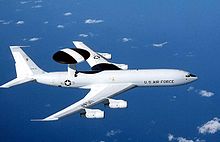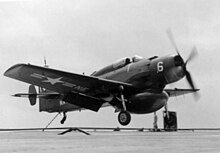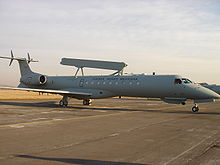Airborne Warning and Control System
An Airborne Early Warning and Control System ( AWACS ) is an airborne radar system . Task of AWACS, the airborne air surveillance and monitoring with the aim of early detection and warning ( english Airborne Early Warning , shortly AEW). Maritime surveillance is one of the tasks of NATO space surveillance. The aircraft are also used as an operations control center in order to be able to direct or coordinate own associations or units directly. Alliances such as NATO and major powers or larger states have such capacities.
The development of AWACS aircraft goes back to 1944, the first AWACS was used from 1946. Today the AWACS is a central component in every air war within the framework of the Network Centric Warfare doctrine. Without such a system, the air superiority and interceptor fighters are dependent in their role on the existing ground-based systems, which, however, can usually not detect low-flying objects.
The Northrop Grumman E-8 airborne command and control center is used for airborne battlefield surveillance on the ground .
history
By 1944, the United States had developed long-range ship-based radar systems , primarily for use by the United States Navy (USN) in the Pacific . It turned out, however, that the advance warning time against attacks was too short and that the ships used as radar outposts suffered heavy losses.
Aircraft carrier based systems
In February 1944, the USN commissioned the Massachusetts Institute of Technology (MIT) to develop an airborne radar system (“Cadillac I” project). A Grumman TBM Avenger equipped with an APS-20 radar was already flying in August . The radar was installed under the aircraft and could detect low-flying aircraft at a distance of about 160 km. 40 TBM-3Ws were completed from March 1945, but they were not used during World War II .
The TBM-3W had a crew consisting of a pilot and a radar officer. The data from the radar were passed on to ships, in whose operations centers the information was evaluated.
For use on aircraft carriers, the USN equipped the Douglas AD Skyraider as an early warning aircraft at the end of the 1940s . The APS-20 found space again under the fuselage, and space was created in the fuselage for two radar officers. Three versions were built, AD-3W (31 machines), AD-4W (168) and AD-5W (218, from 1962 EA-1E), which accounted for almost a fifth of the total production.
As a more powerful successor to the Douglas Skyraider, the Grumman WF-2 Tracer (from 1962 E-1B) was developed from 1954 . This twin-engine machine was the first to have a Hazeltine APS-82 radar installed above the fuselage. As with its predecessors, the radome was immobile and the antenna inside rotated. A new feature of the E-1B was an “Airborne Moving Target Indicator (AMTI)” that was able to better filter out the interference signals from uneven ground and waves. The 88 machines built were in service on USN aircraft carriers from 1958 to 1977.
The successor to the E-1B was the Grumman E-2 Hawkeye from 1965 , which is still in production today. The E-2 was the first to have a rotating radome over the fuselage. American aircraft carriers each have a squadron of four aircraft of this type on board. The E-2 is also used by Egypt, France, Japan, Mexico, Singapore and Taiwan.
Use in Great Britain
Great Britain used 50 AD-4Ws as Skyraider AEW.1 from 1954 to 1960. Then the APS-20 was built into 44 more modern Fairey Gannets , which were used on British aircraft carriers until 1978 (Gannet AEW.3). When most British aircraft carriers were decommissioned in the late 1960s, the APS-20 radars were again removed from the gannets and twelve Avro Shackletons of the Royal Air Force were equipped with them as Shackleton AEW.2. After the planned successor Nimrod AEW.3 was canceled in 1986, the Shackletons remained in service for 46 years until it was replaced by the Sentry AEW.1 in 1991 and the APS-20 radar.
Land-based systems
Also in 1944, the USN commissioned a variant ("Cadillac II") that was to contain a flight control center. The carrier aircraft Douglas C-54 Skymaster as well as the bombers Consolidated B-24 Liberator and Boeing B-17 Flying Fortress were considered. The B-24 was eliminated because it had too little ground clearance for a radar mounted under the fuselage, the C-54 had the most space for radar, equipment and crew. However, since the aircraft were supposed to operate in enemy territory, the choice fell on the heavily armed B-17, although it was the oldest aircraft. Twenty B-17Gs built under license by Douglas were delivered to the Naval Aircraft Modification Unit in Johnsville, Pennsylvania (USA) at the end of 1945 . Instead of the bomb bay, the APS-20 radar was installed under the aircraft. Inside there were three 36 cm radar screens and several display boards as well as extensive communication equipment ( VHF , KW , LW , IFF and LORAN ). With the first machines, the armament was left to the chin and back turret, but later expanded. The machine called PB-1W Fortress was the first AWACS, which flew for the first time in February 1946. To improve radar detection, some machines were later tested with an APS-20 radar mounted on the aircraft.
The Lockheed WV-2 Warning Star was developed for the USN as the successor to the PB-1W . An APS-20 radar was also installed under a Lockheed L-1049 Super Constellation, paired with an APS-45 on the fuselage, which was used to determine the aircraft's altitude more precisely. The USN received from 1956 142 WV-2 (from 1962 EC-121K), the United States Air Force 73 EC-121D. A Warning Star had a crew of 22 and on October 24, 1967, two USAF F-4C Phantom IIs were able to shoot down an enemy aircraft (a North Vietnamese MiG-21) after radar guidance from an EC-121D. The USAF replaced the EC-121 with the Boeing E-3A Sentry until 1978 , the USN's last NC-121K flew until 1982.
Of the E-3, 68 machines were built by 1992, which are used by the USA , NATO , France , Great Britain and Saudi Arabia . The system was developed by Boeing and originally built into the Boeing 707 . It originally only referred to the type of Boeing E-3 Sentry based on the 707 with the distinctive radome that rotates above the aircraft fuselage.
The currently 17 NATO-owned aircraft have Luxembourg aircraft registration numbers and are stationed at the NATO airfield Geilenkirchen near Aachen . 133 Canadian soldiers also work here in the AWACS headquarters, the last of this country in Germany. The RAF also flies from Waddington base on behalf of NATO. In addition, until the end of 2011 there were still three training machines without antenna, so-called TCA (Trainer and Cargo Aircraft) at the base in Geilenkirchen .
In the 1980s, the US Navy carried out the so-called NASP program ( US Navy Airship Program ). The aim was to develop an early warning airship which, in contrast to ship radar, could also detect fast, very low approaching cruise missiles in good time. Goodyear's contribution was based on the design of the AEW airship type ZPG-3W , which was manufactured for the US Navy at the end of the 1950s, and produced the first turboprop airship, the Spirit of Akron , as a test vehicle . However, the order went to Westinghouse Airship Industries , which then also developed a technology platform with the Sentinel 1000 . A dummy was built from the gondola of the originally planned Sentinel 5000 radar carrier . The program was canceled in 1996 after budget cuts.
Development in the Soviet Union
The Soviet Union also developed an AWACS aircraft, the Tupolev Tu-126 , in the 1960s . The radar signals seem to have been severely disturbed by the twin propellers of the four turboprop engines in this aircraft, which was only purchased in nine copies. Successor from 1984 was the Beriev A-50 Schmel based on the transport aircraft Ilyushin Il-76 . A total of around 40 aircraft were built, six for India . The Russian name for the system is DRLO (Dalnoje radiolokazionnoje obnaruschenije, Russian Дальное радиолокационное обнаружение ).
Today's AWACS
-
Beriev A-50 Schmel based on the Ilyushin Il-76 transport aircraft
- Users: Russia , India and the People's Republic of China
-
Beriev A-100 based on the Ilyushin Il-76MD-90A transport aircraft
- User: Russia (currently being tested)
-
Boeing E-3 based on the Boeing 707-320
- Users: United States , NATO E-3A Association and United Kingdom , Saudi Arabia ;
-
Boeing E-767 AWACS based on the Boeing 767-200
- User: Japan
- Boeing Wedgetail based on the Boeing 737 AEW & C with rigid antenna
- Users: Australia , Turkey , South Korea
- Embraer EMB 145 with rigid R99-A antenna
- Grumman E-2 Hawkeye
- Gulfstream G550 Aitam
- IAI EL / W-2090 based on the Ilyushin Il-76 transport aircraft
- User: India
- KongJing-200 based on the Shaanxi Y-8F-600 transport aircraft
- KongJing-500 based on the Shaanxi Y-9 transport aircraft
- KongJing-2000 based on the Ilyushin Il-76 transport aircraft
- Saab 340AEW Erieye with rigid antenna based on the Saab 340AEW Erieye
- Bombardier Globaleye with Saab 340AEW Erieye
- User: United Arab Emirates
See also
- NATO Airborne Early Warning and Control Program Management Organization
- early warning system
- List of aircraft types
- Network Centric Warfare
- C⁴ISR
- Joint Surveillance Target Attack Radar System
- ZPG-3W (radar airship 1950s / 60s)
Web links
- The website of the NATO E-3A-AWACS Association
- Flying radar stations - the AWACS system at luftwaffe.de
- Report by the Bundeswehr about a flight in an E-3: Eye in the sky
- 360 ° indoor shots
- 60 seconds Bundeswehr: AWACS ( YouTube video, May 16, 2018)
Individual evidence
- ↑ Awacs Machines: A Cold War Feeling in the Air , December 29, 2016
- ↑ see the map of Germany from Ursula Lehmkuhl Ed .: Country Report Canada . Series of publications, 10200. Federal Agency for Civic Education BpB, Bonn 2018, in which author. Essay The "Peaceable Kingdom". Canada in the international community 1945 - 2016, map p. 530
- ↑ US Navy considers AEW airship options; FLIGHT INTERNATIONAL; Issue of November 29, 1986 page 12; online as PDF
- ↑ US Navy considers AEW airship options; FLIGHT INTERNATIONAL; Issue of November 29, 1986 page 12; online as PDF
- ↑ a b US Navy awards NASP contract; Flight International, June 20, 1987 edition; Page 29; online as PDF , accessed on December 31, 2016.
- ↑ Peter Kleinheins: The large zeppelins. The history of airship construction. 3. Edition. Springer, Berlin 2005 ISBN 3-540-21170-5 Chapter 17; P. 261
- ↑ Dieter Stammer: Russia's flying radar screens . In: Flieger Revue Extra No. 35. Möller 2011. ISSN 0941-889X . P. 38.










